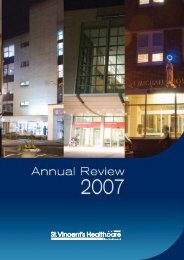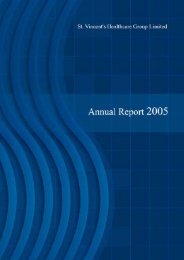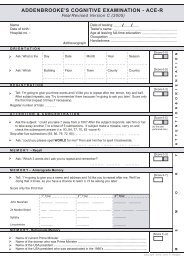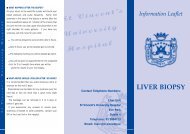The Addenbrooke's Cognitive Examination Revised (ACE-R): a brief ...
The Addenbrooke's Cognitive Examination Revised (ACE-R): a brief ...
The Addenbrooke's Cognitive Examination Revised (ACE-R): a brief ...
Create successful ePaper yourself
Turn your PDF publications into a flip-book with our unique Google optimized e-Paper software.
ace-r: a <strong>brief</strong> cognitive test battery for dementia screening 1083<br />
Figure 2. Bar plot of the VLOM ratio ([verbal fluency þ language]/[orientation þ memory]) against clinical diagnosis (black ¼ FTD,<br />
white ¼ AD, striped ¼ DLB)<br />
AD, MCI and controls: performance on the <strong>ACE</strong>-R<br />
We took subgroups of AD (n ¼ 23) and MCI (n ¼ 23)<br />
patients individually matched to a control group<br />
(n ¼ 23) for age and education. A mixed ANOVA<br />
using the three diagnostic groups and the five <strong>ACE</strong>-R<br />
domains revealed a main effect of diagnosis<br />
(F (2,66) ¼ 43.168, p < 0.001) as well as an interaction<br />
between diagnosis and domains (Greenhouse-Geisser<br />
corrected, F (2,66) ¼ 34.965, p < 0.001). Subsequent t-<br />
tests demonstrated that the MCI group differed<br />
significantly from controls in terms of <strong>ACE</strong>-R final<br />
score (t ¼ 4.462, df ¼ 44, p < 0.001), attention/orientation<br />
(t ¼ 2.727, df ¼ 44, p < 0.05) memory<br />
(t ¼ 4.364, df ¼ 44, p < 0.001), fluency (t ¼ 2.347,<br />
df ¼ 44, p < 0.05), and language (t ¼ 2.730, df ¼ 44,<br />
p < 0.05). Comparing MCI and AD, t-tests revealed<br />
significant differences between <strong>ACE</strong>-R total score<br />
(t ¼ 5.313, df ¼ 44, p < 0.001), attention/orientation<br />
(t ¼ 5.813, df ¼ 44, p < 0.001), memory (t ¼ 5.046,<br />
df ¼ 44, p < 0.001), fluency (t ¼ 2.650, df ¼ 44,<br />
p < 0.05), language (t ¼ 2.591, df ¼ 44, p < 0.05),<br />
and visuospatial (t ¼ 2.813, df ¼ 44, p < 0.05) (see<br />
Table 5).<br />
DISCUSSION<br />
We hoped that changes in the <strong>ACE</strong>-R would result in<br />
better sensitivity and specificity. <strong>The</strong> most striking<br />
finding was the positive predictive value, which was<br />
100% at the lower cut-off of 82 for a range of<br />
prevalence rates. This suggests that the <strong>ACE</strong>-R could<br />
be used to diagnose dementia in settings with very<br />
different expected rates of dementia. This finding is<br />
explicable in the light of the changes in that insensitive<br />
Table 5. Comparison of performance on the <strong>ACE</strong>-R (total and sub-scores) in controls, MCI and AD (n ¼ 23 per group). <strong>ACE</strong>-R sub-scores<br />
shown as percentage since totals vary<br />
Controls (n ¼ 23) MCI (n ¼ 23) AD (n ¼ 23) Controls vs MCI<br />
p-values<br />
MCI vs AD<br />
p-values<br />
<strong>ACE</strong>-R total score 92.6 84.2 66.4 ** **<br />
Attention/Orientation(%) 98.6 95.4 75.4 * **<br />
Memory (%) 88 68.6 42.5 ** **<br />
Fluency (%) 81.7 71.1 53.4 * *<br />
Language (%) 96.7 92.1 84.3 * *<br />
Visuospatial (%) 97 92.9 76.6 n.s. *<br />
Copyright # 2006 John Wiley & Sons, Ltd. Int J Geriatr Psychiatry 2006; 21: 1078–1085.<br />
DOI: 10.1002/gps

















